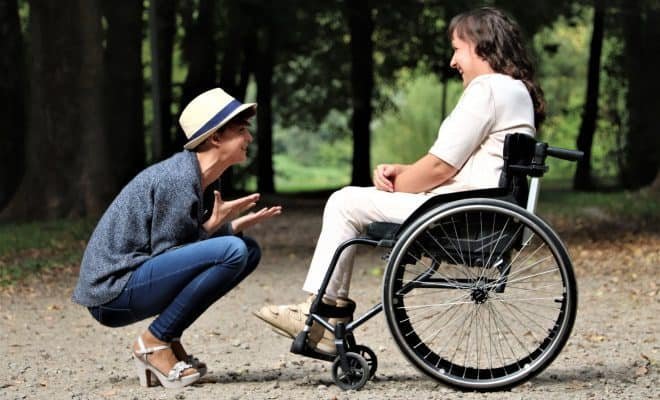The More You Know: A Brief Look Into Personal Care Attendant Services And Medicaid Waivers

From a young age, I began receiving personal care attendant services. A Personal Care Attendant (which can also be referred to as a Personal Care Assistant, or a Personal Care Service Provider) is someone who assists individuals with physical disabilities, cognitive impairments, and other needs related to an individual’s activities of daily living. These tasks may include, but are not limited to: assistance with dressing, light housekeeping, and helping individuals to get out into the community. When a person receives personal care attendant services, they have a plan of care that is specifically tailored to what will best help them get their individual needs met. Personal care attendant services are funded through Medicaid waiver programs.
Medicaid Waiver programs help provide services to individuals who would otherwise be in an institution, nursing home, or hospital to receive long-term care in the community. Prior to 1991, the Federal Medicaid program paid for services only if a person lived in an institution. The approval of Federal Medicaid Waiver programs allowed states to provide services to consumers in their homes and in their communities.
Common types of Medicaid Waiver Programs
- Katie Beckett or TEFRA (Tax Equity and Fiscal Responsibility Act)This waiver was passed in 1982 and it allows children under nineteen years of age to receive personal care services in their home regardless of their parents’ income level, provided that the cost of in-home care is less or equal to the cost of receiving the care in a hospital setting. After the age of nineteen, the individual will transition to a Managed Care waiver or a Home and Community Based care waiver.
- Section 1915(b) Managed Care Waivers: Managed Care waivers are waivers that individual states can apply for in order to provide services through managed care delivery systems or otherwise limit people’s choice of medical or home care providers.
- Section 1915(c) Home and Community-Based Services Waivers: States can apply for waivers to provide long-term care services in home and community settings rather than institutional settings.
States can also provide both 1915(b) and 1915(c) waivers together in congruence of services to the elderly and people with disabilities, as long as the individuals meet the federal requirements for both waiver programs.
As a person that has lived in multiple states, with the hope of traveling more, one of the major drawbacks of Medicaid and the waiver programs is that eligibility is based on a state-by-state basis rather than a universal model. What this means is that if a person decides to move to a different state, as I have in the past, their Medicaid Healthcare and personal care attendant coverage ends. This means you need to reapply and be placed on a waitlist. You are not given a specific time as to when or if your coverage will be reinstated. Thus, making it extremely difficult to get medical or personal care attendant needs met. When you do not have the means to pay out of pocket, these essential needs get very expensive very quickly.
I have been in charge of my own care from the time that I was eighteen years old and went away to college. In that time, I have had many different Personal Care Attendants, as well as service agencies. As you can imagine, this allows someone to get to know many different types of people and personality types. Just like with anything else, there are pros and cons to this, along with some things that I have learned through the years and continue learning today. As I said, you have the opportunity to meet all different types of people which allows you to expand your mind and get to know what makes people tick on a level that you would not on a day-to-day basis. You learn to have patience in a capacity that most people will never need and, I would like to believe, this gives you a perspective of looking at things through a lens that others may not have the ability to do.
Due to the nature of working with your personal care attendant, oftentimes you build close bonds because you get to know them quite personally. I have met some of my best and closest friends through them being my personal care attendant. On the flip side of that, and a lesson that I have learned to be more mindful of through the years is to have a professional boundary. This can be difficult at times because you do work together so closely but it is a balance point to keep in mind for both parties involved. Being your own “boss” is not always an easy thing to do, especially when you have an attendant that does their job half-heartedly. What might be helpful is to discuss needs and expectations from the beginning and even write down what tasks need to be accomplished during each shift to ensure that your needs are being met.
Since Personal Care Attendants are most often paid by state-funded programs, each person is given a case manager who oversees their case. However, this field, along with many other medical fields, often experience a tremendous shortage due to the fact that there are not enough staff people to cover the number of people that need services. This can be extremely frustrating for all parties involved, especially the individuals in need of receiving services because they are in an extremely vulnerable position. My advice would be to keep the lines of communication open for everyone involved so that you all are on the same page.
If an individual is not able to communicate with the personal care attendant or agency by themselves, ensure a trusted individual is able to closely monitor the care that is being received through verbal or written correspondence. Communication and advocacy are vital in making sure that everyone’s needs are met, individuals are being treated with dignity and respect, and that everyone gets the care that they deserve. For more information please contact medicaid.gov or the Independent Living Center or Health and Human Services Agency in your area.










